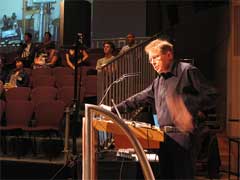 On Sunday i painfully woke up on time to listen to Paul DeMarinis whom i thought would present his work (in particular The Messenger, Golden Nica – Interactive Art) at the Interactive Art Forum. But heeey, too bad De Marinis was not there and Erkki Huhtamo gave the talk instead. What a great talk! It was probably far better than one could hope for in the absence of the artist.
On Sunday i painfully woke up on time to listen to Paul DeMarinis whom i thought would present his work (in particular The Messenger, Golden Nica – Interactive Art) at the Interactive Art Forum. But heeey, too bad De Marinis was not there and Erkki Huhtamo gave the talk instead. What a great talk! It was probably far better than one could hope for in the absence of the artist.
Podcast of his talk in german.
Huhtamo is an Associate Professor at UCLA, Dept. of Design | Media Arts. His research focuses on media art and media archaeology. He has curated international exhibitions of digital art, including major retrospectives of Toshio Iwai, Perry Hoberman and on one of Paul DeMarinis six years ago.
Huhtamo calls DeMarinis a “thinkerer”, someone who thinks and tinkers. He first went through several pieces by DeMarinis such as:
– Mechanization Takes Command, a performance with Laetitia Sonami and her “augmented” pair of rubber kitchen gloves;
– Fire Birds in which the recorded voices of dictators from the mid-1930s — Hitler, Stalin, Mussolini — emanate from gas flames in birdcages;
– Four foxhole radios, a series of working radios constructed from unlikely materials such as chewing gum wrappers, empty bottles of whiskey and rusty nails inspired by the fact that during the war soldiers in World War II had to build up their own radios out of very low pieces of technology. DeMarinis defines his way of working as Edisonian, because like Edison he didn’t really have any formal education. His research is experimental. He tries to see what’s working and what fails, meticulously writing down the result of each experiment.
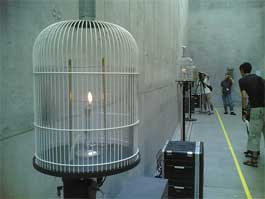
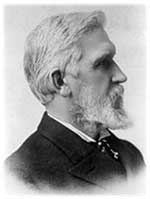 Fire Birds and a portrait of Elisha Gray
Fire Birds and a portrait of Elisha Gray
DeMarinis is also a media archaeologist who intensively searches archives, patent archives in particular to find about forgotten inventors. One of such losers is Elisha Gray who invented the telephone but arrived with the patent a few hours after Alexander Graham Bell.
Gray also invented several curious instruments such as a Wasbasin Transmitter and a Musical Bathtub. He had the idea for the later in 1874 when he heard the refrain of the rheotome issuing from his bathroom. There his nephew was ‘taking shocks’ to amuse smaller children. With a vibrating rheotome in the circuit of an induction coil, the boy connected one end of the secondary coil to the zinc lining of the bathtub and held the other end in his hand. When the boy’s hand glided along the lining, it produced a whining sound in tune with the rheotome. Gray found that quick, hard rubbing made the noise even louder than that of the rheotome itself. When he varied the pitch of the rheotome, the noise followed suit.
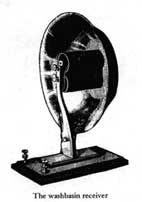
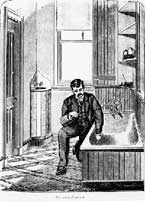
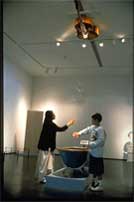 Wasbasin Transmitter, Musical Bathtub and Gray Matter
Wasbasin Transmitter, Musical Bathtub and Gray Matter
In 1995, DeMarinis came up with his own version of Gray’s forgotten invention: Gray Matter, a series of electrified objects that produce sound and sensation when stroked with the hand.
DeMarinis emulates the idea of the artist as a meta inventor. He has the freedom to explore and imagine because he’s neither a scientist nor an historian.
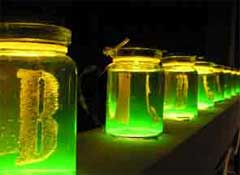 His award-winning piece, The Messenger (1998-2005) features three parallel telegraph sytems based on the DeMarinis incoming email messages. The three of them are imaginary but function perfectly: a first system is made of 26 washbasins with each basin assigned a letter in the alphabet. Built-in loudspeakers serially intone the individual letters of the incoming e-mail. The second features 26 dancing skeletons wearing ponchos displaying one of the letters of the alphabet. The third is made of 26 electrolytic jars with metal electrodes in the form of the letters A to Z that bubble when electricity is passed through them.
His award-winning piece, The Messenger (1998-2005) features three parallel telegraph sytems based on the DeMarinis incoming email messages. The three of them are imaginary but function perfectly: a first system is made of 26 washbasins with each basin assigned a letter in the alphabet. Built-in loudspeakers serially intone the individual letters of the incoming e-mail. The second features 26 dancing skeletons wearing ponchos displaying one of the letters of the alphabet. The third is made of 26 electrolytic jars with metal electrodes in the form of the letters A to Z that bubble when electricity is passed through them.
DeMarinis was inspired by XVIIIth Century physician and naturalist Francesc Salva i Campillo’s output device for his telegraph equipment. The system involved 26 different wires that send electroshocks. At the end of the wire is a servant who is assigend a letter of the alphabet. When a servant receives an electrical stimulation, he or she had to utter the letter assigner “I” or “R”, etc. A 27th servant had to write down the letters that composed the message. Another of Salva’s idea was to use 26 jars that make bubbles each time a letter from the message is sent. The servant has thus to run from a jar to the other to write down the message.
“The Messenger,� takes telegraphy as its point of departure for an examination of the interrelationship of electricity and democracy. “The Messenger� deals with how electronic communications technologies, in addition to enriching our lives and experiences, also contribute to our loneliness and isolation.
